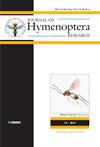Quantitative形态学和mtDNA分析表明,maltaeus并非马耳他群岛特有(膜翅目,蚁科)
IF 1.4
3区 农林科学
Q2 ENTOMOLOGY
引用次数: 0
摘要
Lasius maltaeus Seifert, 2020最近被描述为马耳他特有蚂蚁,基于定量形态学,经过几十年对当地种群身份的不确定性,其表型类似于L. emarginatus (Olivier, 1791)。同时,发现西西里L. emarginatus种群在线粒体DNA上存在一定程度的分化,表明存在异质性。考虑到马耳他岛和西西里岛生物地理上的相似性,直到最后一次冰川极大期都有陆桥将它们反复连接起来,我们质疑马尔他菌是马耳他特有的假设。我们将数量形态学和mtDNA整合到马耳他和意大利南部种群表型接近L. emarginatus的研究中。我们发现L. maltaeus的分布范围遍及西西里岛的大部分地区,而真正的L. emarginatus在该岛的东北部、附近的伊奥利亚群岛和意大利半岛取代了它。L. emarginatus和L. maltaeus在西西里岛的分布遵循着复杂的古地理历史的生物地理模式。进一步的调查应该证实真正的马耳他特有蚂蚁的存在,因为其他所谓的特有物种的地位并没有得到强有力的支持。本文章由计算机程序翻译,如有差异,请以英文原文为准。
Quantitative morphology and mtDNA reveal that Lasius maltaeus is not endemic to the Maltese Islands (Hymenoptera, Formicidae)
Lasius maltaeus Seifert, 2020 was recently described as a Maltese endemic ant based on quantitative morphology, after decades of uncertainties over the identity of the local population, which has a phenotype resembling L. emarginatus (Olivier, 1791). At the same time, Sicilian L. emarginatus populations were discovered to diverge in their mitochondrial DNA to a degree that suggested heterospecificity. Considering the biogeographic similarity of Malta and Sicily, with land bridges connecting them repeatedly until the last glacial maximum, we questioned the assumption that L. maltaeus was endemic to Malta. We integrated quantitative morphology and mtDNA in the study of the Maltese and southern Italian populations phenotypically close to L. emarginatus. We discovered that the range of L. maltaeus extends over most of Sicily, while the true L. emarginatus replace it in the north-eastern sector of the island, the nearby Aeolian Islands, and the Italian peninsula. The distributions of L. emarginatus and L. maltaeus in Sicily follow biogeographic patterns recalling the island’s complex paleogeographic history. Further investigations should verify the existence of truly Maltese endemic ants, since the status of other allegedly endemic species is not strongly supported.
求助全文
通过发布文献求助,成功后即可免费获取论文全文。
去求助
来源期刊
CiteScore
2.60
自引率
15.40%
发文量
68
审稿时长
>12 weeks
期刊介绍:
The Journal of Hymenoptera Research is a peer-reviewed, open-access, rapid online journal launched to accelerate research on all aspects of Hymenoptera, including biology, behavior, ecology, systematics, taxonomy, genetics, and morphology.
All published papers can be freely copied, downloaded, printed and distributed at no charge for the reader. Authors are thus encouraged to post the pdf files of published papers on their homepages or elsewhere to expedite distribution. There is no charge for color.

 求助内容:
求助内容: 应助结果提醒方式:
应助结果提醒方式:


